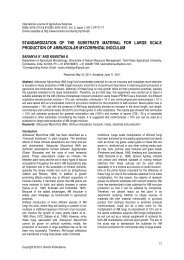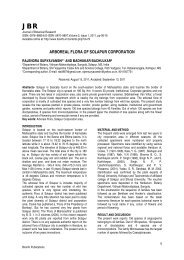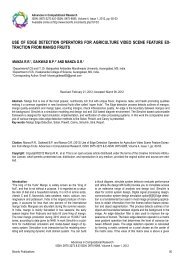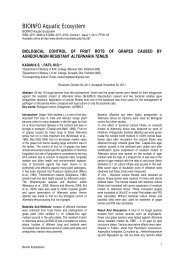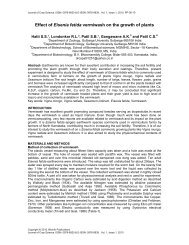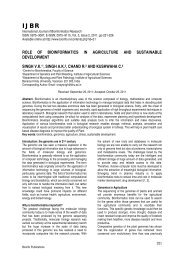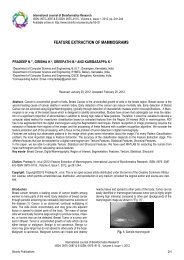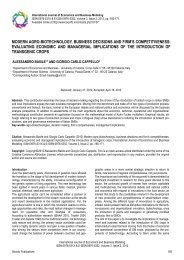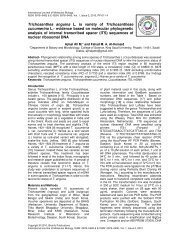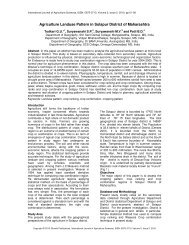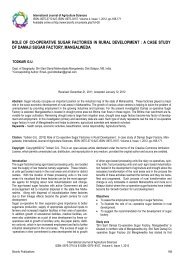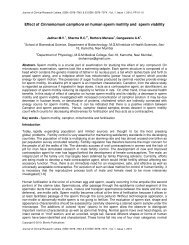In silico Study of tertiary structure and binding - Bioinfo Publications
In silico Study of tertiary structure and binding - Bioinfo Publications
In silico Study of tertiary structure and binding - Bioinfo Publications
Create successful ePaper yourself
Turn your PDF publications into a flip-book with our unique Google optimized e-Paper software.
<strong>In</strong> <strong>silico</strong> <strong>Study</strong> <strong>of</strong> <strong>tertiary</strong> <strong>structure</strong> <strong>and</strong> <strong>binding</strong> interaction <strong>of</strong> Pr<strong>of</strong>ilin – Schizosaccharomyces pombe<br />
many organisms, <strong>of</strong> which the ubiquitously expressed<br />
PFN1 is considered for normal cellular functions 28,<br />
13 .The many neurospora has provided insights into<br />
biological processes have been enumerated briefly 29,<br />
30 . The entire genome <strong>of</strong> the species contains 38,<br />
69,769 base pairs <strong>of</strong> DNA encode: 10,082 proteins<br />
(9,200 <strong>of</strong> them longer ect than 100 amino acid) 424<br />
tRNAs, 74 rRNAs, 175-200 copies <strong>of</strong> the 25S/17S/<br />
5.8S gene cluster 31 .<br />
Materials <strong>and</strong> Methods<br />
Tools for in <strong>silico</strong> analysis<br />
Sequence analysis<br />
<strong>In</strong> this protocol we analyzed the sequence <strong>of</strong> pr<strong>of</strong>iling<br />
from Neurospora crassa.<br />
Multiple sequence alignment<br />
We used dynamic programming for analysis <strong>of</strong><br />
conserved region from set <strong>of</strong> gene which is similar in<br />
diversified species.<br />
MSWQAYVDSSLVGTGHIDKAAIISAAGDSTWAATP<br />
GFTLSPDEMKFISAVLGDNGKGSNVDKVFAEGLHV<br />
AGQRYVAFNIEGRHVYRQGKTGVIIVKTTQAILVAHY<br />
GENAVAGNSTQTVEALADYLVKAGY (GenBank<br />
85106701)<br />
Structure analysis<br />
The 3D SM server takes the sequence <strong>of</strong> the protein<br />
which is interesting <strong>and</strong> attempts to predict its 3D –<br />
<strong>structure</strong> <strong>and</strong> also its function. The probe is scanned<br />
by 3D-PSSM library using the global dynamic<br />
programming algorithm. The amino acid sequence <strong>of</strong><br />
the protein <strong>of</strong> interest is submitted in FASTA format<br />
with a one line description about the protein. An<br />
email ID is indispensable as the result are mailed<br />
MSWQAYVDSSLVGTGHIDKAAIISAAGDSTWAATP<br />
GFTLSPDEMKFISAVLGDNGKGSNVDKVFAEGLHV<br />
AGQRYVAFNIEGRHVYRQGKTGVIIVKTTQAILVAHY<br />
GENAVAGNSTQTVEALADYLVKAGY (GenBank<br />
85106701)<br />
The server generates the results with an in depth<br />
analysis. The browser comes up with proteins that<br />
are very similar to the query sequence after searching<br />
the non redundant protein databanks. The secondary<br />
<strong>structure</strong> is predicted by using PSI-Blast. The<br />
matching <strong>of</strong> the sequences the server comes up with<br />
the list <strong>of</strong> proteins with similar domain <strong>and</strong> also<br />
classifies the protein in to the super family based on<br />
its properties using SCOP- (Structural classification <strong>of</strong><br />
protein) by scanning the library.<br />
Spatial restraints<br />
MODELLER 32 is a computer program that models<br />
three dimensional <strong>structure</strong>s <strong>of</strong> proteins <strong>and</strong> their<br />
assemblies by satisfaction <strong>of</strong> spatial restraints.<br />
MODELLER is most frequently used for homology or<br />
comparative proteins <strong>structure</strong> modeling. The user<br />
provides an alignment <strong>of</strong> a sequence to be modeled<br />
with known related <strong>structure</strong> <strong>and</strong> MODELLER will<br />
automatically calculate a model with all non hydrogen<br />
atoms.<br />
There are three kinds <strong>of</strong> input files protein data Bank<br />
atom files with co-ordinates for the template <strong>structure</strong>,<br />
the alignment file with the alignment <strong>of</strong> the template<br />
<strong>structure</strong>s with the target sequence <strong>and</strong> MODELLER<br />
comm<strong>and</strong>s in script files that instruct MODELLER<br />
what to do.<br />
Each atom file is named code.atm where code is a<br />
short protein code –PDB code while 1ypr.atm the<br />
code must be used as that proteins identifier<br />
throughout the modeling. The alignment is done in<br />
PIR format. MODELLER is comm<strong>and</strong> line only tool<br />
<strong>and</strong> has no graphical user interface; MODELLER<br />
comm<strong>and</strong>s<br />
Stereo chemical analysis<br />
PROCHECK suite <strong>of</strong> programs 33 for assessing the<br />
stereo chemical quality <strong>of</strong> a given protein <strong>structure</strong>.<br />
The aim <strong>of</strong> PROCHECK is to assess how normal or<br />
conversely how unusual, the geometry <strong>of</strong> the residues<br />
in a given protein <strong>structure</strong> is as compared with stereo<br />
chemical parameters derived from well refined high<br />
resolution <strong>structure</strong>s. The parameters are to be<br />
described in details 34 .<br />
PROCHECK is the PDB file 35 holding the co-ordinates<br />
<strong>of</strong> the <strong>structure</strong> <strong>of</strong> interest. PROCHECK generates a<br />
number <strong>of</strong> output files in the default directory which<br />
have the same name as the original PBD file but with<br />
different extensions.<br />
Molecular optimization<br />
The program Auto Dock was developed to provide an<br />
automated procedure for predicting the interaction <strong>of</strong><br />
lig<strong>and</strong>s with biomolecular targets. The motivation for<br />
this work arises from problems in the design <strong>of</strong><br />
bioactive compounds <strong>and</strong> in particular the field <strong>of</strong><br />
computer aided drug design. Bio macromolecule: -<br />
Neurospora crassa pr<strong>of</strong>ilin <strong>and</strong> Lig<strong>and</strong>s: - Poly-L –<br />
proline<br />
Results & <strong>In</strong>terpretation<br />
The template selection was carried out on basis <strong>of</strong><br />
sequence <strong>and</strong> secondary <strong>structure</strong> similarity, (Table<br />
1) shows the results <strong>of</strong> the search programs<br />
mentioned above <strong>and</strong> their respective statistical<br />
scores that were considered in selecting the best<br />
template. A systematic representation <strong>of</strong> the multiple<br />
sequence alignment <strong>of</strong> target Neurospora crassa<br />
<strong>In</strong>ternational Journal <strong>of</strong> Agriculture Sciences, ISSN: 0975-3710, Volume 1, Issue 1, 2009 2



